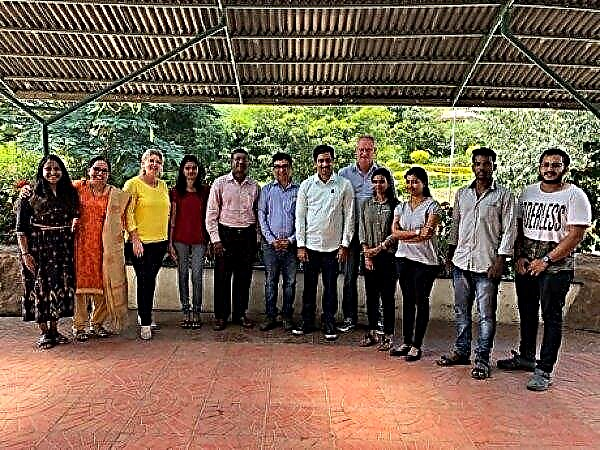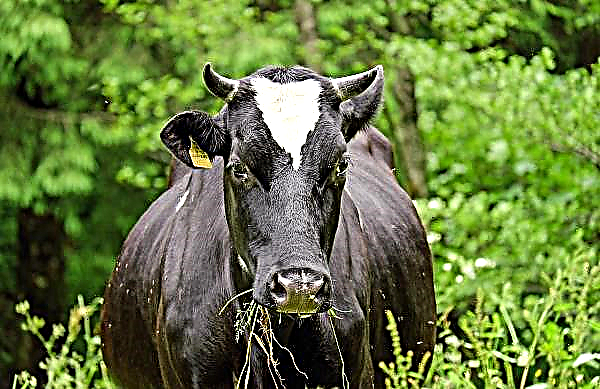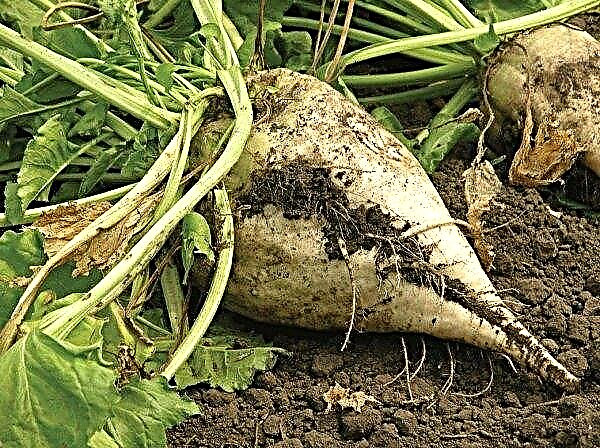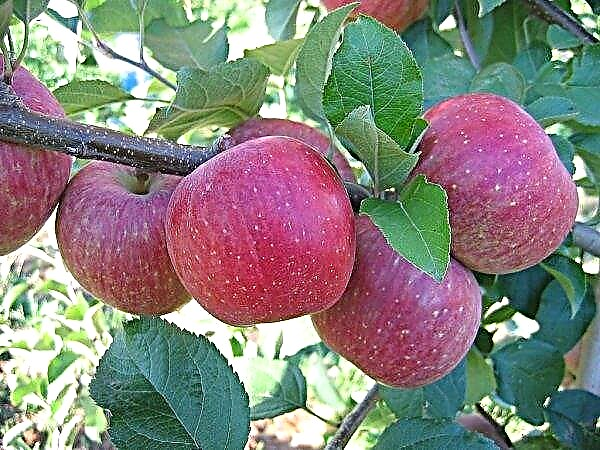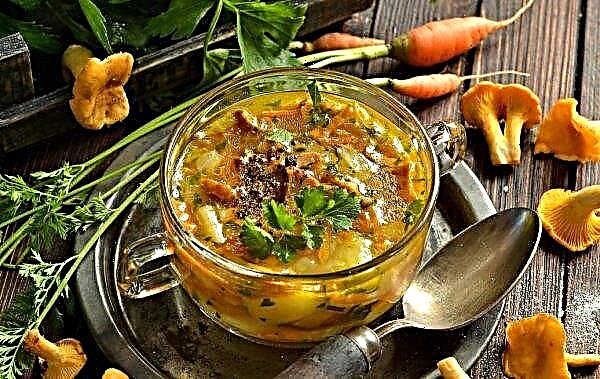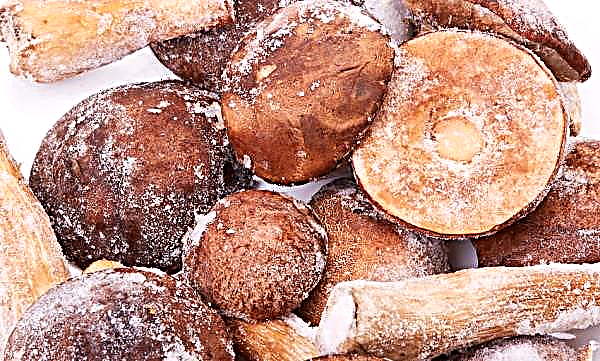Dessert pear “Sverdlovchanka” is the result of domestic selection, which is able to please gardeners with high productivity, good winter hardiness and large fruit sizes. How to grow a pear properly, and how to care for it to get the maximum yield - later in the article.
Breeding History and Breeding Region
The Sverdlovchanka variety was created by domestic breeders of the Sverdlovsk and Saratov experimental stations. Scientists, by pollinating the Lukashovka pear with the pollen of several southern varieties of culture, were able to grow seedlings, which later, through vaccination, propagated and transported to the warmer region of the state - the Saratov region.
Important! Pear refers to self-infertile plants, which without the presence of a donor pollen are not able to bear fruit. That is why, in the process of planting seedlings, you need to think about planting varieties of pollinators.
At present, the described pear variety is recommended for cultivation in the aforementioned region, central regions, and in the Urals. For its pollination, experts advise using Permyachka and Severyanka varieties, whose proximity positively affects the growth and fruiting of Sverdlovchanka.
Description of the variety "Sverdlovchanka"
Pear "Sverdlovchanka" refers to the category of autumn-summer varieties of dessert destination. It is characterized by excellent resistance to frost, not moodiness in leaving and excellent keeping quality of fruits.
Tree

The culture is a tree with an average growth rate, low density, up to 8 m high. Pear shoots grow upward, have a greenish-gray color.
Crohn has a wide pyramidal shape. Leaves - a classical form for all pears, dark green in color, with a smooth, shiny surface.
During flowering, small, white cup-shaped flowers that later form fruits form on the crop. The tree is characterized by early maturity; the first fruits can be harvested 3-4 years after planting material is planted.
Fruit
The fruits of “Sverdlovchanka” are pears of a rather large size, elongated pear-shaped, weighing 120-180 g. The peel of ripe fruit has a greenish-yellow color, however, a slight blush may appear from the side of exposure to sunlight.
The pear skin is dense, with distinct subcutaneous points; it chews well when eaten. The pulp is characterized by a high juice content, oiliness, single impregnations of stony grains, the color is yellow, the taste is sour-sweet, has a pleasant, well-defined aroma.

The fruits are held tight to the tree with the help of a thick stalk, which prevents them from shedding after ripening. A special tasting commission evaluated the taste of Sverdlovchanka by 4.5 points out of 5.
The variety is famous for its good yield indicators, which, under favorable climatic conditions and competent care, amount to 200 centners of production per hectare of land.
Pros and cons of the Sverdlovchanka pear variety
The technical qualities of the described variety have long been appreciated by domestic gardeners.
- A pear is characterized by a large number of significant benefits, among which there are:
- frost resistance of the culture, the ability to tolerate low temperatures up to –38 ° C;
- high commercial quality of fruits;
- pleasant taste of fruits, their excellent keeping quality and transportability;
- compact tree;
- early maturity;
- not high requirements in care and cultivation.
Did you know? Pear pulp is an excellent natural source of hormones of happiness and joy - endorphins. That is why, juicy and aromatic fruits are recommended for use in depression, nervous agitation, stress.
- Among the disadvantages of the variety are considered the most significant:
- the need for pollinators, since the pear is self-infertile;
- soil quality requirements.
Seedling selection and planting technology
High-quality, healthy and strong seedling is the key to successful further growth and fruiting of the pear. That is why, the choice of planting material should be taken as seriously as possible.
Signs of a healthy seedling are:
- strong, elastic, strong root processes, without signs of rot, dryness, damage or disease;
- smooth, elastic, uniform bark color, without dryness, roughness and wrinkling. The wood under the bark should have a fresh, green hue.

In the southern and central regions, seedlings can be planted in late August - early September, so that before the onset of cold weather, it can take root and root well. In the northern regions, planting events are recommended in the spring, when the land warms up a bit.
For planting, you need to choose a young seedling, under the age of two years, since an older plant will not take root well and bear fruit much later. Pear prefers the most spacious, bright and warm place, which is well protected from drafts and cold winds that have a negative impact on the development of the tree.
We recommend that you familiarize yourself

The main part of the root shoots of the culture is located at a depth of 20 to 100 cm, which is why you should choose a site with a depth of underwater no closer than 2 m.
For planting, the best option is sandy-clay or loamy soil with a neutral level of acidity, black soil is ideal. The seat should be prepared in advance, presumably one to two weeks before planting the crop.
To do this, dig a recess, with a depth of 70-75 cm and a width of 100 cm. The size of the pit should be such that the entire root system of the pear freely fits into it.
Planting a seedling is carried out according to the traditional algorithm:
- part of the soil removed from the pit is mixed with 3 buckets of humus, one bucket of sand, 250 g of superphosphate and 25-30 g of potassium;
- a drainage layer of expanded clay, pebble or broken brick is lined at the bottom of the seat;
- on top of the drainage layer, a little nutritious soil mixture is poured, from which a mound is made;
- a wooden peg is inserted into the earthen mound, which will serve as a support for the seedling;
- plant is put on the ground, root processes are gently straightened;
- Sprinkle the seedling with soil so that the root neck is 6-8 cm above the surface;
- the earth around the near-stem circle is slightly tamped and watered abundantly with two buckets of well-maintained, not cold water;
- the soil around the plant is mulched, the seedling is tied to a peg.

In the first year of development, the planted seedling should be organized with the highest quality and competent care, because it will depend on this further fruiting of the tree.
Further plant care after planting
Pear care consists in carrying out standard measures - watering, top dressing, pruning, preventive treatment. However, agricultural activities must be carried out regularly and in a timely manner.
Feeding, watering
Until the plant takes root, it must be regularly moistened, 2-3 times a week. It is especially important to organize high-quality irrigation during pear flowering, in the phase of fruit formation and after harvesting. For irrigation events, experts advise making a small ditch around the tree and pour water into it.

As soon as moisture is absorbed into the soil, the recess should be sprinkled with soil. The norm of watering on one tree is 2-3 bucket. It is very important when watering to maintain a moisture balance, since both excessive drought and stagnation of water in the soil adversely affect the state of the root system and the development of the plant itself.
After wetting, the earth around the trunk must be well loosened, mulched with hay or sawdust. Such events will prevent the development of weeds, enrich the earth with nutrients and oxygen, and also retain moisture for a long time.
Check out

- in spring, when the snow comes down, the pear is fed with organic fertilizers, for example, humus, manure or compost;
- during the period of intensive vegetation, nitrogen-containing products are introduced under the plant, which activates the growth of green mass;
- in the phase of flowering and fruit setting, the culture is fed with chicken droppings or liquid manure.
Pruning
Sverdlovchanka, although it is a tree with medium thickening, however, needs annual pruning and crown formation. Pruning of branches should be carried out in early spring, before the plant enters the vegetation phase, or in autumn at a temperature of 0 ...– 5 ° С. Activities should be carried out with a sharp, disinfected knife or pruner.
A two-year-old seedling is advised to cut at a height of half a meter from the base. Thus, the main trunk is shortened by a quarter. Each year, thin out branches that thicken the tree, thereby reducing its productivity. Pruning should be done under the very base of the branches, without leaving stumps.

Also, experts annually advise doing sanitary pruning by removing dry, damaged, weak or diseased branches. After the procedure, all places of the cuts should be treated with chopped charcoal or garden var.
Cold preparation
When cultivating pears in the southern and central regions, it is not necessary to prepare the tree for cold weather in a special way. It is still recommended to insulate young plants before wintering by wrapping the trunk with “breathing”, natural material, such as burlap or store insulation.
When growing crops in the northern regions, it is necessary not only to protect the trunk, but after the snow falls, form a snow mound around the plant, at least one meter high.
Did you know? In folk medicine, not only pear fruit is widely used, but also leaves. The greenery of the plant contains unique substances that have an antifungal effect. That is why, decoctions of leaves are excellent for dermatitis, fungal infections of the skin, eczema.
Pest and Disease Control Methods
Sverdlovchanka variety shows excellent resistance to many ailments, in particular scab, rust and bacterial burn. However, in rare cases, in violation of agricultural standards, it may be exposed to powdery mildew and soot fungus. To treat the latter, the pear is sprayed with a soap solution and then tobacco. In the case of powdery mildew, damaged branches and foliage are removed and burned. To prevent the occurrence of pests or the development of diseases, experts advise observing some simple rules of prevention:
To prevent the occurrence of pests or the development of diseases, experts advise observing some simple rules of prevention:
- prevent excessive moisture of the tree;
- always keep the trunk circle clean, clear the soil of weeds, mulch and loosen;
- collect fallen fruits on time, as they are a good nursery of fruit rot;
- carry out preventive spraying of the culture with insecticidal and fungicidal preparations.
Like other varieties of pears, Sverdlovchanka can also become a “victim” spider mite, shields or aphids.

In order to prevent the development of the problem, it is necessary to regularly inspect the plant for parasites, as well as to spray with a wide spectrum of insecticides.
Important! Often, the crown of a pear becomes an excellent treat for ants. Therefore, in order to protect the fruits, you need to wrap the trunk in a special belt treated with an insect repellent, or use special traps, adhesive tapes.
Tips from experienced gardeners for beginners
Often, beginning gardeners may have difficulties associated with growing a pear and caring for it.
To minimize the likelihood of such problems, experienced gardeners recommend a few simple tips:

- when watering, it is better to "under-milk" the plant than to overfill, since stagnation of water in the soil can provoke rotting of the root system, which will entail the death of the whole culture;
- with abundant fruit fall, it is advised to establish pear watering schemes and introduce a small dosage of mineral fertilizers into the soil that can strengthen the tree;
- remove pears in dry, warm weather. Fruits collected in the morning, evening or during high humidity are poorly preserved;
- for long-term preservation, fruits should be stored in wooden or plastic boxes in several layers, each shifted with sawdust or straw. The optimal conditions for storing fruits are considered to be a temperature of 0 ... + 3 ° C and a relative humidity of 80-85%.
Pear "Sverdlovchanka" has a number of key advantages, thanks to which many domestic gardeners fell in love. It is characterized by strong and strong immunity, rarely gives in to diseases and pest attacks, bears fruit well, does not require special conditions for cultivation, is quite simple and unpretentious in care.

